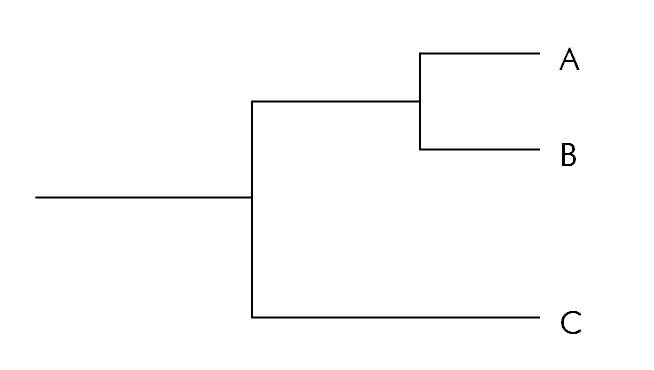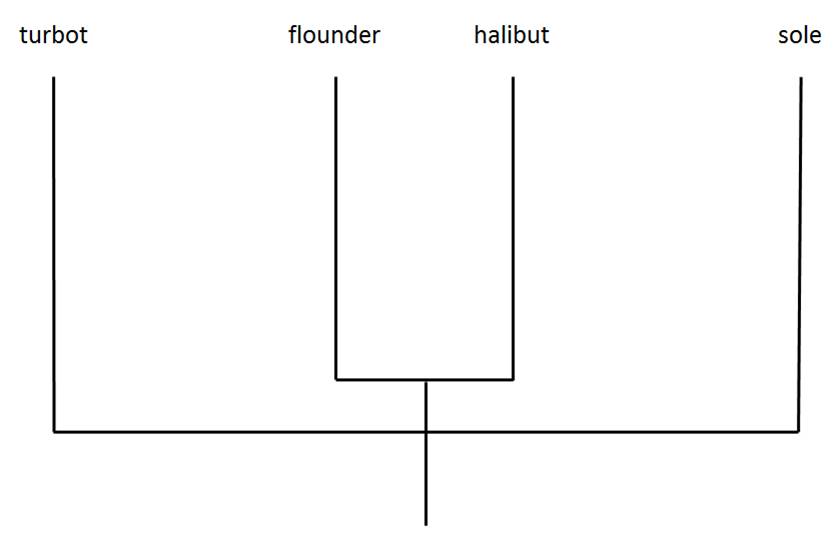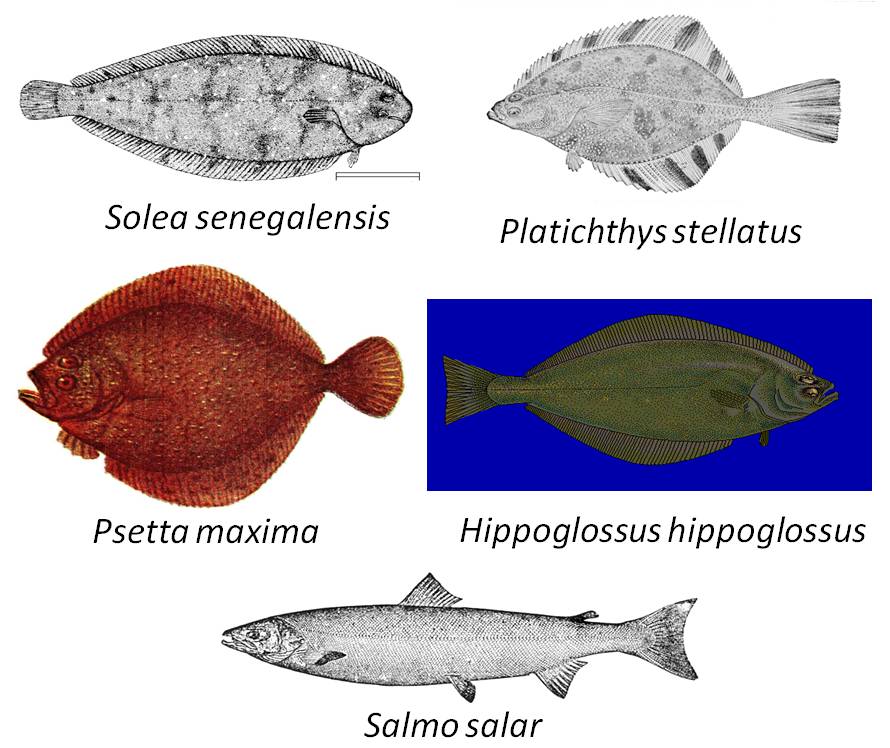Meet the Flatfish
In this assignment, you'll explore the evolutionary relationships between several different species of fish. The fish you'll meet are commonly known as "flatfish", and the proper classification of these fish has been a work in progress for decades. In this first section of the assignment, you'll watch the video called "Meet the Flatfish", and work with a phylogenetic tree that was generated based on detailed observation of the morphology (the structure of the body and its parts) of the several groups that make up the larger group known as the flatfish.
A phylogenetic tree is a visual hypothesis about the relatedness of the species or groups that it includes, and like any other hypothesis it can be used to generate predictions. When interpreting a phylogenetic tree, it's important to remember that the more closely related two species are, the shorter the distance to their most recent common ancestor on the phylogenetic tree. For example, in the tree below, species A is more closely related to species B than to species C.
Watch Meet the Flatfish, and use the video plus the images on this page to answer the questions in this section of the assignment document.

Figure 1. Sample phylogenetic tree showing the evolutionary relationships of species A, B, and C.
The arrangement of the flatfish families in the phylogenetic tree shown in the video (and reproduced in Figure 2 below) is based upon Chapleau's 1993 study, which generated a phylogenetic tree arranging the flatfish families based on extremely detailed morphological study of the members of those families.

Figure 2. Phylogenetic tree displaying evolutionary relationships among four flatfish species, based on morphological evidence. Adapted from Chapleau (1993).
In Figure 3 below, you will see the four representatives of the order Pleuronectiformes that you learned about in the video, and you will also see a representative of another order, the Salmoniformes. Recall that 'order' is the taxonomic level below 'class'. The orders Salmoniformes and Pleuronectiformes belong to the same class, the Actinopterygii (the "ray-finned fishes"). All of the members of class Actinopterygii share several major morphological features such as the structure of their scales (Hart and Reynolds, 2002). Similarly, all of the members of each order within the class share certain features that distinguish them from members of other orders, and all of the members of each family within an order share certain features that distinguish them from members of other families.
Click on any of the fish to open up a larger version of the figure.
Figure 3. Representatives of two orders of ray-finned fish. Solea senegalensis, Platichthys stellatus, Psetta maxima, and Hippoglossus hippoglossus belong to the order Pleuronectiformes; Salmo salar belongs to the order Salmoniformes.
From Morphology to Molecules
Recall once more that a phylogenetic tree is a hypothesis about the relatedness of the groups shown on the tree. Morphological data were traditionally used to generate phylogenetic trees, but in recent years it has become possible to compare DNA and protein sequences between groups, and to use this data to generate phylogenetic trees. Sometimes the relationships proposed by a tree constructed using molecular data are the same as the relationships proposed by a tree constructed using morphological data, and the molecular data provide support for the morphological data. Other times, molecular data help to reveal aspects of the relationships between species that were not apparent when using morphological data alone.
Because a phylogenetic tree is a hypothesis, we can use the tree to generate a testable prediction. If the species on the tree in Figure 2 are related in the way that this tree suggests that they are based on their morphology, then we might expect the species to show these resemblances at the molecular (DNA and protein) level. In the next section of this assignment, you will test a prediction about the molecular similarities of your fish species. First, you will use the morphology-based phylogenetic tree from Figure 2 to generate a prediction (see the related question in the assignment document).
Pairwise Alignment of DNA Sequences
See the assignment document for full instructions for this part of the lab.
Image Credits
Figure 1: created by Gillian Gass.
Figure 2: adapted from Chapleau F. 1993. Pleuronectiform relationships: a cladistic reassessment. Bulletin of Marine Science. 52: 516-540.
Figure 3 (alphabetical order by common name):
- Atlantic halibut (Hippoglossus hippoglossus) by Robbie N. Cada [Public domain], via Wikimedia Commons and FishBase
- Atlantic salmon (Salmo salar) by Hertwig, Richard (1909), A Manual of Zoology, New York: Henry Holt and Company, p. 603 [Public domain], via Wikimedia Commons
- senegalese sole (Solea senegalensis) by FAO [CC BY-NC 3.0], via FishBase
- starry flounder (Platychthys stellatus) by Anonym [Public domain], via Wikimedia Commons
- turbot (Psetta maxima) by Iduns kokbok [Public domain], via Wikimedia Commons
References
Hart PJB, Reynolds JD. 2002. Handbook of fish biology and fisheries, vol. 1. Wiley-Blackwell.


